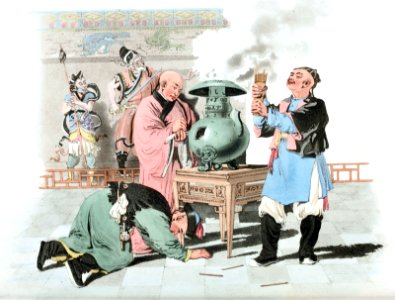Drawing by william alexander, draughtsman of the macartney embassy to china in 1793. A temple visitor kneeling before the sacred urn, in which perfumed sticks are burning during sacrifice. A priest whose head is entirely shaved wears a loose dress of silk or nankeen, the color of which is characteristic of a particular sect. Against the wall of the temple two statutes are located separated from the worshipers by the low railing. The person on the right is anxiously watching the fall of tallies, which he is shaking in a joint of bamboo; these are marked with certain characters, and as they fall, the characters are inserted by the priest in the book of fate. After the ceremony, the priest communicates to the votary the success of his prayers. Alexander noted that the chinese had no regular sabbath, or fixed time for worshipping the deity in congregation. Their temples were constantly open, and were visited on every important undertaking, such as an intended marriage, the commencement of a long journey, building a house, etc. Image taken from the costume of china, illustrated in forty-eight coloured engravings, published in london in 1805. Date: circa 1800.
Loading...
